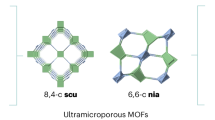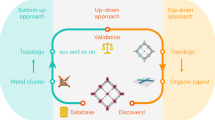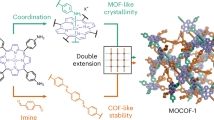Abstract
Metal–organic frameworks typically rely on discrete molecules as building units, and creating frameworks featuring continuous organic or inorganic subnet moieties, such as chains and layers, is challenging. While all-inorganic subnets have been used as units with infinite connectivity, the intrinsic disorder in organic chains and layers hinders their role as well-defined building blocks for reticular materials. Here we report the one-pot synthesis of a series of Zr6O8-based or Hf6O8-based metal–organic frameworks that feature boroxine-based one-dimensional and two-dimensional covalent organic frameworks—chains with diverse conformations and layers with specific topology, respectively—as the organic components. The spatial compatibility between the constituents locks the infinite organic units into patterned arrangements and thus generates metal–organic frameworks with distinct structural entities and pore environments in separate sections along specific directions. The coexistence of extended covalent organic frameworks and discrete inorganic units, side by side and yet independent of each other, leads to high structural compartmentalization in space.

This is a preview of subscription content, access via your institution
Access options
Access Nature and 54 other Nature Portfolio journals
Get Nature+, our best-value online-access subscription
$32.99 / 30 days
cancel any time
Subscribe to this journal
Receive 12 print issues and online access
$259.00 per year
only $21.58 per issue
Buy this article
- Purchase on SpringerLink
- Instant access to full article PDF
Prices may be subject to local taxes which are calculated during checkout





Similar content being viewed by others
Data availability
All data that support the findings of this study are available in the paper and its Supplementary Information. X-ray crystallographic data for the structures reported in this article have been deposited at the Cambridge Crystallographic Data Centre (CCDC) under deposition numbers 2416824 (for MOF-401), 2416825 (for MOF-402), 2416826 (for MOF-403), 2416827 (for MOF-404), 2416828 (for MOF-404-oF), 2416829 (for MOF-404-mF), 2416830 (for MOF-405), 2416831 (for MOF-406F), 2457479 (for MOF-401(Hf)), 2457480 (for MOF-403(Hf)), 2457481 (for MOF-404(Hf)) and 2457482 (for MOF-405(Hf)). Copies of the data can be obtained free of charge via https://www.ccdc.cam.ac.uk/structures/. Source data are provided with this paper.
References
Yaghi, O. M., Kalmutzki, M. J. & Diercks, C. S. Introduction to Reticular Chemistry (Wiley-VCH, 2019).
Furukawa, H., Cordova, K. E., O’Keeffe, M. & Yaghi, O. M. The chemistry and applications of metal‒organic frameworks. Science 341, 1230444 (2013).
Slater, A. G. & Cooper, A. I. Function-led design of new porous materials. Science 348, aaa8075b (2015).
Kalmutzki, M. J., Hanikel, N. & Yaghi, O. M. Secondary building units as the turning point in the development of the reticular chemistry of MOFs. Sci. Adv. 4, eaat9180 (2018).
Geng, K. et al. Covalent organic frameworks: design, synthesis, and functions. Chem. Rev. 120, 8814–8933 (2020).
Yaghi, O. & Li, H. Hydrothermal synthesis of a metal‒organic framework containing large rectangular channels. J. Am. Chem. Soc. 117, 10401–10402 (1995).
Li, H., Eddaoudi, M., O’Keeffe, M. & Yaghi, O. M. Design and synthesis of an exceptionally stable and highly porous metal–organic framework. Nature 402, 276–279 (1999).
Kitagawa, S., Kitaura, R. & Noro, S. Functional porous coordination polymers. Angew. Chem. Int. Ed. 43, 2334–2375 (2004).
Férey, G. et al. A chromium terephthalate-based solid with unusually large pore volumes and surface area. Science 309, 2040–2042 (2005).
Zhang, J.-P., Zhang, Y.-B., Lin, J.-B. & Chen, X.-M. Metal azolate frameworks: from crystal engineering to functional materials. Chem. Rev. 112, 1001–1033 (2011).
Li, B. et al. Emerging multifunctional metal–organic framework materials. Adv. Mater. 28, 8819–8860 (2016).
Yuan, S. et al. Stable metal–organic frameworks: design, synthesis, and applications. Adv. Mater. 30, 1704303 (2018).
Jiang, H., Alezi, D. & Eddaoudi, M. A reticular chemistry guide for the design of periodic solids. Nat. Rev. Mater. 6, 466–487 (2021).
Cheetham, A. K., Rao, C. N. R. & Feller, R. K. Structural diversity and chemical trends in hybrid inorganic–organic framework materials. Chem. Commun. 2006, 4780–4795 (2006).
Serre, C. et al. Very large breathing effect in the first nanoporous chromium(III)-based solids: MIL-53 or CrIII(OH)·{O2C−C6H4−CO2}·{HO2C−C6H4−CO2H}x·H2Oy. J. Am. Chem. Soc. 124, 13519–13526 (2002).
Guillou, N., Livage, C., Beek, W., Noguès, M. & Férey, G. A layered nickel succinate with unprecedented hexanickel units: structure elucidation from powder-diffraction data, and magnetic and sorption properties. Angew. Chem. Int. Ed. 42, 643–647 (2003).
Vaidhayanathan, R., Natarajan, S. & Rao, C. N. R. Aliphatic dicarboxylates with three-dimensional metal–organic frameworks possessing hydrophobic channels. Dalton Trans. 2003, 1459–1464 (2003).
Shyu, E. & LaDuca, R. L. Divalent metal succinate/perchlorate coordination polymers incorporating a kinked hydrogen bonding capable diimine: chains, layers and a (5,6)-connected binodal network featuring alternating rectangular and hexagonal grids. Polyhedron 28, 826–834 (2009).
Zhang, L. et al. Synthesis, structure, and luminescent properties of hybrid inorganic–organic framework materials formed by lead aromatic carboxylates: inorganic connectivity variation from 0D to 3D. Inorg. Chem. 48, 6517–6525 (2009).
Schoedel, A., Li, M., Li, D., O’Keeffe, M. & Yaghi, O. M. Structures of metal‒organic frameworks with rod secondary building units. Chem. Rev. 116, 12466–12535 (2016).
Smolders, S. et al. A titanium(IV)-based metal–organic framework featuring defect-rich Ti-O sheets as an oxidative desulfurization catalyst. Angew. Chem. Int. Ed. 58, 9160–9165 (2019).
Noa, F. M. A. et al. A unified topology approach to dot-, rod-, and sheet-MOFs. Chem 7, 2491–2512 (2021).
Jia, H., Han, Q., Luo, W., Cong, H. & Deng, H. Sequence control of metals in MOF by coordination number precoding for electrocatalytic oxygen evolution. Chem Catal. 2, 84–101 (2022).
Sun, C., Xi, R. & Fei, H. Organolead halide-based coordination polymers: intrinsic stability and photophysical applications. Acc. Chem. Res. 56, 452–461 (2023).
Zhang, W. et al. Metal-halide porous framework superlattices. Nature 638, 418–424 (2025).
Shimizu, G. K. H., Vaidhyanathan, R. & Taylor, J. M. Phosphonate and sulfonate metal organic frameworks. Chem. Soc. Rev. 38, 1430–1449 (2009).
Côté, A. P. et al. Porous, crystalline, covalent organic frameworks. Science 310, 1166–1170 (2005).
Diercks, C. S. & Yaghi, O. M. The atom, the molecule, and the covalent organic framework. Science 355, eaal1585 (2017).
Han, X. et al. Chiral covalent organic frameworks: design, synthesis and property. Chem. Soc. Rev. 49, 6248–6272 (2020).
Zhang, W. et al. Reconstructed covalent organic frameworks. Nature 604, 72–79 (2022).
Han, J. et al. Fast growth of single-crystal covalent organic frameworks for laboratory x-ray diffraction. Science 383, 1014–1019 (2024).
Yin, Y. et al. Ultrahigh-surface area covalent organic frameworks for methane adsorption. Science 386, 693–696 (2024).
Wang, Z. et al. Flux synthesis of two-dimensional covalent organic frameworks. Nat. Protoc. 19, 3489–3519 (2024).
Chen, F. et al. Exploring high-connectivity three-dimensional covalent organic frameworks: topologies, structures, and emerging applications. Chem. Soc. Rev. 54, 484–514 (2025).
Li, Y. et al. Integration of metal–organic frameworks and covalent organic frameworks: design, synthesis, and applications. Matter 4, 2230–2265 (2021).
Lv, S. et al. Metal–coordinated covalent organic frameworks as advanced bifunctional hosts for both sulfur cathodes and lithium anodes in lithium-sulfur batteries. J. Am. Chem. Soc. 146, 9385–9394 (2024).
Endo, K. et al. Crystalline porous frameworks based on double extension of metal–organic and covalent organic linkages. Nat. Synth. 4, 603–613 (2025).
Liu, Y. et al. Weaving of organic threads into a crystalline covalent organic framework. Science 351, 365–369 (2016).
Zhao, Y. et al. A synthetic route for crystals of woven structures, uniform nanocrystals, and thin films of imine covalent organic frameworks. J. Am. Chem. Soc. 139, 13166–13172 (2017).
Xu, H.-S. et al. Single crystal of a one-dimensional metallo-covalent organic framework. Nat. Commun. 11, 1434 (2020).
Lu, H.-S. et al. A 3D anionic metal covalent organic framework with soc topology built from an octahedral TiIV complex for photocatalytic reactions. Angew. Chem. Int. Ed. 60, 17881–17886 (2021).
Han, W.-K. et al. Targeted construction of a three-dimensional metal covalent organic framework with spn topology for photocatalytic hydrogen peroxide production. Chem. Eng. J. 449, 137802 (2022).
Han, W.-K. et al. Integrating light-harvesting ruthenium(II)-based units into three-dimensional metal covalent organic frameworks for photocatalytic hydrogen evolution. Angew. Chem. Int. Ed. 61, e202208791 (2022).
Koricha, A. L. & Iovine, P. M. Boroxine chemistry and applications: a perspective. Dalton Trans. 39, 1423–1431 (2010).
Zhan, G. et al. Observing polymerization in 2D dynamic covalent polymers. Nature 603, 835–840 (2022).
Preuss, M. D. et al. Functionalization of supramolecular polymers by dynamic covalent boroxine chemistry. Angew. Chem. Int. Ed. 63, e202402644 (2024).
Torres-Huerta, A. et al. Structural induction via solvent variation in assemblies of triphenylboroxine and piperazine—potential application as self-assembly molecular sponge. Cryst. Growth Des. 17, 2438–2452 (2017).
Ono, K. et al. Dynamic interconversion between boroxine cages based on pyridine ligation. Angew. Chem. Int. Ed. 57, 3113–3117 (2018).
Bhandary, S., Shukla, R. & Hecke, K. V. Effect of chemical substitution on the construction of boroxine-based supramolecular crystalline polymers featuring B←N dative bonds. CrystEngComm 24, 1695–1699 (2022).
Wang, W. et al. Dative B←N bonds based crystalline organic framework with permanent porosity for acetylene storage and separation. Chem. Sci. 14, 533–539 (2023).
Li, Y. et al. Self-healing B←N-based hydrogen-bonded organic framework for exclusive recognition and separation of toluene from methyl-cyclohexane. J. Am. Chem. Soc. 146, 19425–19433 (2024).
Xu, J. et al. Visible light-responsive crystalline B←N host adducts with solvent-induced allosteric effect for guest release. Angew. Chem. Int. Ed. 63, e202411880 (2024).
Kong, X.-J. et al. Constructing new metal–organic frameworks with complicated ligands from “one-pot” in situ reactions. Chem. Sci. 10, 3949–3955 (2019).
Liu, W. et al. Reticular synthesis of metal–organic frameworks by 8-connected quadrangular prism ligands for water harvesting. Angew. Chem. Int. Ed. 62, e202305144 (2023).
Ortín-Rubio, B. et al. A mesoporous Zr-based metal–organic framework driven by the assembly of an octatopic linker. Chem. Commun. 59, 7803–7806 (2023).
Gong, W. et al. Modulator-dependent dynamics synergistically enabled record SO2 uptake in Zr(IV) metal–organic frameworks based on pyrene-cored molecular quadripod ligand. J. Am. Chem. Soc. 145, 26890–26899 (2023).
Sheepwash, E. et al. Molecular networks based on dative boron–nitrogen bonds. Angew. Chem. Int. Ed. 50, 3034–3037 (2011).
Zhao, Z.-H., Li, C.-H. & Zuo, J.-L. Dynamic polymeric materials based on reversible B–O bonds with dative boron-nitrogen coordination. SmartMat 4, e1187 (2023).
Xiao, X. et al. Formation of polyrotaxane crystals driven by dative boron–nitrogen bonds. Sci. Adv. 9, eadi1169 (2023).
Chen, B. & Jäkle, F. Boron-nitrogen Lewis pairs in the assembly of supramolecular macrocycles, molecular cages, polymers, and 3D materials. Angew. Chem. Int. Ed. 63, e202313379 (2024).
Willems, T. F. et al. Algorithms and tools for high-throughput geometry-based analysis of crystalline porous materials. Microporous Mesoporous Mater. 149, 134–141 (2012).
Walton, K. S. & Snurr, R. Q. Applicability of the BET method for determining surface areas of microporous metal–organic frameworks. J. Am. Chem. Soc. 129, 8552–8556 (2007).
Yang, S. et al. A partially interpenetrated metal–organic framework for selective hysteretic sorption of carbon dioxide. Nat. Mater. 11, 710–716 (2012).
Haase, F. & Lotsch, B. V. Solving the COF trilemma: towards crystalline, stable and functional covalent organic frameworks. Chem. Soc. Rev. 49, 8469–8500 (2020).
Li, X. et al. An imine-linked metal–organic framework as a reactive oxygen species generator. Angew. Chem. Int. Ed. 60, 2534–2540 (2021).
Acknowledgements
This work was supported by the National Key Research and Development Program of China (grants 2018YFA0209401 and 2021YFA1500400), the National Natural Science Foundation of China (grants 21922103, 21961132003, 22088101, 22331009 and U22A20401) and the Science and Technology Commission of Shanghai Municipality (grant 2024ZDSYS02). We thank L. Hou, Z. Jiang and Y. Rao for their assistance with the structure refinement and illustration.
Author information
Authors and Affiliations
Contributions
B.L., H.-L.J. and Q.L. conceived the project. H.-L.J. and Q.L. supervised the project. B.L. designed and performed the syntheses. B.L. and Y.W. performed the structure characterizations and porosity studies. L.W. also performed the syntheses. B.L., Y.W., H.-L.J. and Q.L. wrote the paper. All authors contributed to the data analysis, discussion and revision of the paper.
Corresponding authors
Ethics declarations
Competing interests
The authors declare no competing interests.
Peer review
Peer review information
Nature Chemistry thanks Shuhei Furukawa and Fernando Uribe-Romo for their contribution to the peer review of this work.
Additional information
Publisher’s note Springer Nature remains neutral with regard to jurisdictional claims in published maps and institutional affiliations.
Extended data
Extended Data Fig. 1 Structures of MOF-401‒403.
Single crystal structures of MOF-401 (a) and MOF-402 (c), each depicting one spn net, and the structure of MOF-403 (e). The corresponding linkers, 0D-L1 (b), 0D-L2 (d), and 0D-L3 (f), are highlighted with their cores colored pink. Blue polyhedra represent Zr. Grey, red, and pink spheres represent C/N, O, and B atoms, respectively.
Extended Data Fig. 2 Structures of MOF-404 and MOF-405.
Single crystal structures of MOF-404 (a) and MOF-405 (c), and their corresponding linkers 1D-L1 (b) and 1D-L2 (d). B3O3 and pyridyl rings are colored pink. Blue polyhedra represent Zr. Grey, red, and pink spheres represent C/N, O, and B atoms, respectively.
Extended Data Fig. 3 Structure of MOF-406.
Extended structure of MOF-406 (a) and its corresponding linker 2D-L1 (b). B3O3 and pyridyl rings are colored pink. Blue polyhedra represent Zr. Grey, red, and pink spheres represent C/N, O, and B atoms, respectively.
Extended Data Fig. 4 Pore size and shape illustration of MOF-401‒405.
Interpenetrated MOF-401 (a) and MOF-402 (b) exhibit cylindrical pore channels; MOF-403 (c) contains two interconnected cage types; and each of MOF-404 (d) and MOF-405 (e) features two kinds of prismatic channels.
Supplementary information
Supplementary Information
Supplementary Figs. 1–48, Tables 1–10 and Discussion.
Supplementary Data 1
Source data for Supplementary Fig. 10.
Source data
Source Data Fig. 5
Source data for the adsorption and desorption isotherms in Fig. 5a and the micropore size distribution profiles in Fig. 5b.
Rights and permissions
Springer Nature or its licensor (e.g. a society or other partner) holds exclusive rights to this article under a publishing agreement with the author(s) or other rightsholder(s); author self-archiving of the accepted manuscript version of this article is solely governed by the terms of such publishing agreement and applicable law.
About this article
Cite this article
Liu, B., Wu, Y., Wang, L. et al. Covalent organic frameworks as infinite building units for metal–organic frameworks with compartmentalized pores. Nat. Chem. (2025). https://doi.org/10.1038/s41557-025-01953-2
Received:
Accepted:
Published:
DOI: https://doi.org/10.1038/s41557-025-01953-2



